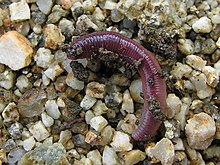Hermaphrodite
Hermaphrodite is a term which comes from Hermaphroditus, the son of Hermes and Aphrodite. It is used as a scientific term in biology.

In zoology, an animal which can produce both sperm and ova is a hermaphrodite. As an example, most earthworms are hermaphrodites. A simultaneous hermaphrodite has both sets of sex organs throughout life. A sequential hermaphrodite has ovaries at first, replaced by a testis later, or the other way round.[1]
In botany, hermaphrodite is used for 'complete' flowers with both male and female parts, and for plants which have bisexual reproductive units. See flowering plant sexuality for details.[2]
With people, the term hermaphrodite is not correct, because true functioning hermaphrodites are not possible in humans. What sometimes happens is errors in development which lead to intersex persons. A definition of intersex is:
- "... individuals of a bisexual species that have characteristics intermediate between the male and female".[1]
People who are intersex may have a very small penis and no testicles, or a very small and short vagina and a large clitoris that looks like a penis. The term hermaphrodite is considered offensive and outdated by many intersex people.
References
change- ↑ 1.0 1.1 King R.C. Stansfield W.D. & Mulligan P.K. 2006. A dictionary of genetics. 7th ed, Oxford University Press, p202 and 234. ISBN 0-19-530761-5
- ↑ Molnar S. 2004. Plant reproductive systems